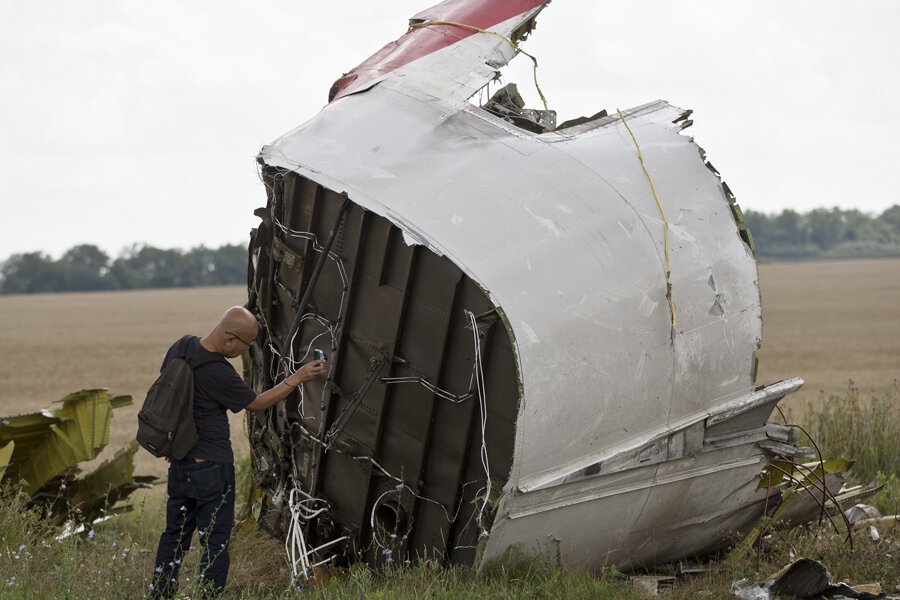Fighter jets shot down: How many planes has Ukraine lost?
Only six days after Malaysia Airlines flight MH17 was shot down over eastern Ukraine, two Ukrainian Su-25 fighter jets were also shot down in the same vicinity, near the village of Dmytrivka close to the Russian border. Since Ukraine began its anti-terror operations in mid-April, its Air Force has been hit hard, raising questions about the weapons rebels possess – as well as the impact on the capability and size of Ukraine's fleet.
In today's incident, Ukraine's Ministry of Defense statement blamed “pro-Russian terrorists” using antiaircraft missiles (links in Ukrainian). It said that the two planes were hit despite taking anti-missile maneuvers, and that the pilots ejected, most likely landing on territory “controlled by members of illegal armed groups.” Ukrainian military spokesman Andriy Lysenko told Interfax Ukraine that the two planes were not shot down from Ukrainian territory, implying, as Ukraine has before, that the attack came from Russian territory. Mr. Lysenko said the planes were flying at a height of 5,200 meters (over 17,000 feet).
It is unclear what has happened to the pilots. A ministry spokesperson told the Washington Post that a witness saw one parachute open. The two planes were shot down as the first bodies from MH17 arrived back in Europe. Rebels claimed responsibility, while still denying their involvement in the earlier downing of MH17.
How much can Ukraine handle?
Even before the world’s attention turned to the downing of MH17, the Ukrainian Air Force had lost several planes and helicopters. Below is a timeline of incidents involving planes, based on media reports and Ukrainian government statements.
-April 22, July 1, and July 2: Ukrainian planes are hit by fire but manage to land safely.
-June 6: An An-30 surveillance plane was shot down near Slovyansk. Three people are reported dead.
June 14: An Il-76 military transport plane was shot down in Luhansk by a shoulder-fired missile. All 49 people on board are reported dead.
July 14: An-26 military transport plane was shot down. Exact casualties are unknown.
July 16: An Su-25 was shot down. No casualties were reported. Rebels claim to have shot down two Su-25s, but the Ukrainian government says that while a second plane was hit, it landed safely.
July 17: Malaysia Airlines flight MH17 is shot down, most likely by an SA-11 missile. All 298 people on board died.
July 23: Two Ukrainian Su-25 shot down by rebels. The status of the pilots is unknown.
Russia has continued to deny that it supplies rebels in Ukraine with the weapons needed to shoot down planes. Yesterday, a senior US intelligence official told reporters that Russia was responsible for “creating the conditions” that led to MH17's downing, but that there was no evidence directly linking the involvement of the Russian government.
Rebel leader Alexander Khodakovsky of the Vostok Battalion, confirmed to Reuters today that rebels did have possession of the BUK missile system most likely used to shoot down MH17. Mr. Khodakovsky, however, still blamed Ukraine over the incident, saying, "Even if there was a BUK, and even if the BUK was used, Ukraine did everything to ensure that a civilian aircraft was shot down."
IHS Jane’s, a information group that covers the defense industry, reported in June on the weaknesses of Ukraine's Air Force since the country's independence in 1991. And while precise military figures are unknown, several months of military operations against rebels have further debilitated Air Force capabilities.
Ukraine's air force has suffered from chronic underinvestment since the country's independence, with the bulk of its inventory either mothballed or otherwise inoperable.
According to IHS Jane's World Air Forces data, Ukraine still possesses a fleet of 24 Su-24Ms, 36 Su-25s, 45 Su-27s, 20 An-26s and 140 MiG-29s - although 39 of these were captured when Belbeck airbase in Crimea was taken by Russian forces. Estimates of how many of Ukraine's remaining aircraft are actually in operational service, however, range from around half to less than a quarter.
.







